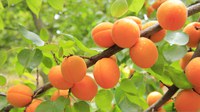Dakota Gardener: Growing apricots in North Dakota
(Click an image below to view a high-resolution image that can be downloaded)
By Tom Kalb, Horticulturist
NDSU Extension
The delicate blossoms of an apricot tree can take your breath away.
These white and pink flowers burst open in April while other trees are still sleeping. It’s an amazing sight and a sign that spring is upon us.
But winters in North Dakota do not go away quickly or quietly. In many years, apricot blossoms suffer frost injury and the tree fails to produce fruits.
How can we enjoy both the splendor of apricot blossoms in spring and their golden fruits in summer?
We need to delay the blooming as long as possible.
Start by location. Plant your tree near your home and away from frost pockets.
All fruit trees like a sunny spot, but plant your apricot tree where it gets only the morning sun. An east-facing location is ideal.
Avoid an open southern or western exposure. The afternoon sun under these exposures during a warm spell in April can trigger the flower buds to open early. This may lead to frosted blossoms and a barren tree.
Next, mulch the tree with shredded bark or wood chips. These organic mulches will insulate the soil, preventing extreme temperature swings and preventing the soil from warming up quickly in spring. This will keep the tree cool and delay its blooming.
Do not use rock mulches. These mulches generate heat around the tree, causing apricot trees to open their buds prematurely. Rocky mulches lead to fruitless trees.
There are lots of apricot varieties to choose from. Let’s select a variety that can survive our frigid winters yet bloom late in spring.
I look to the Canadian prairies for solutions here.
The variety Scout comes from Manitoba and will wait to bloom until May. Its golden fruits are juicy and good for desserts, canning and drying.
Westcot is another freestone type from Manitoba. Freestone pits are easy to remove when processing. Westcot fruits are large and have a mild, sweet flavor.
Debbie’s Gold is a freestone type with a firm texture. It’s popular for canning and fresh eating.
Brookcot produces yellow-orange fruits with a red blush. Its flesh is juicy and flavorful. This semi-freestone type comes from Alberta.
Each of these varieties will produce fruits on their own but will produce larger crops if you plant more than one variety.
There is no way to guarantee an apricot crop every year. Our weather in early spring is too harsh and unpredictable.
But if you select among these Canadian varieties, grow them in a cool spot and mulch them, you may enjoy both brilliant blossoms and delicious fruits. Good luck!
For more information about gardening, contact your NDSU Extension county agent. Find the Extension office for your county at www.ndsu.edu/agriculture/extension/county-extension-offices.
NDSU Agriculture Communication – March 14, 2023
Source: Tom Kalb, 701-328-9722, tom.kalb@ndsu.edu
Editor: Kelli Anderson, 701-231-6136, kelli.c.anderson@ndsu.edu




